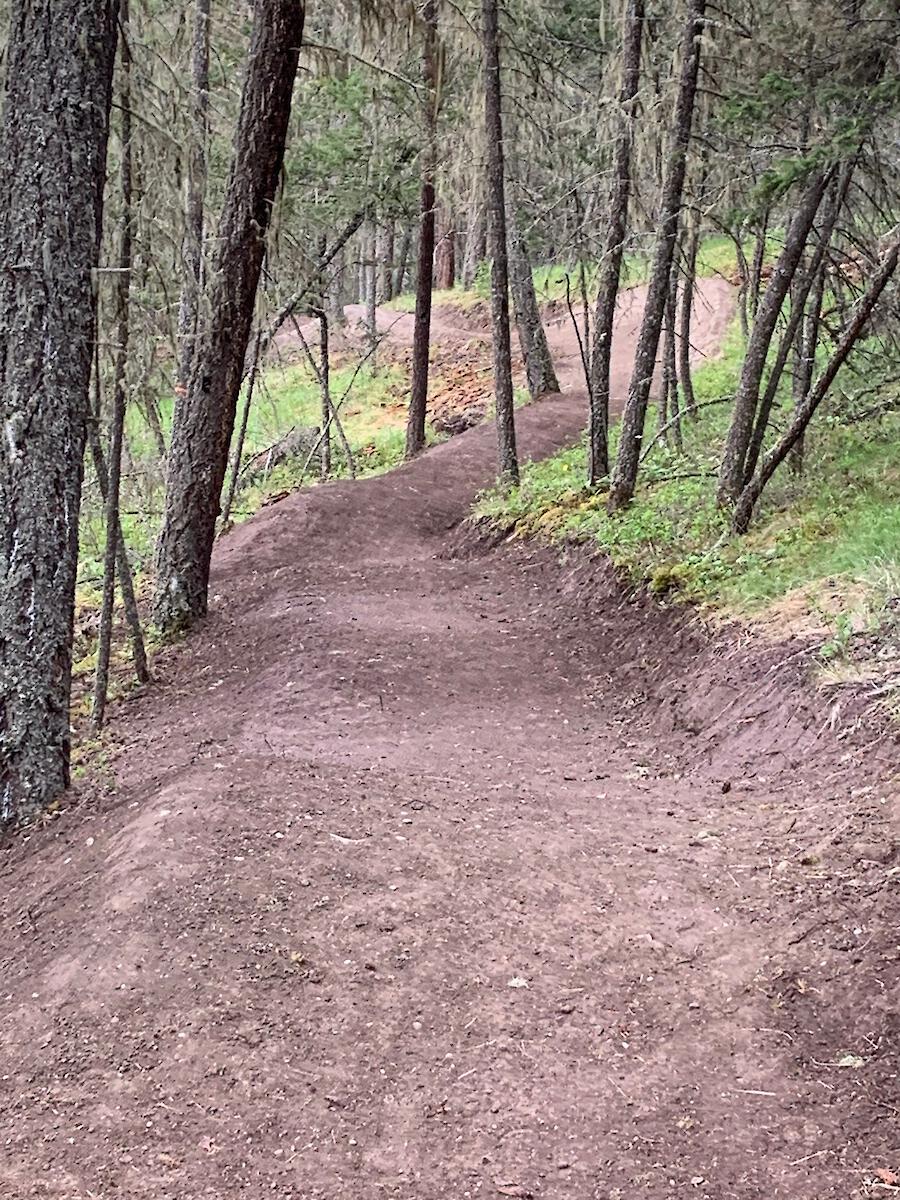
Ode to the Uphill Berm
New Trail Feature Makes Flow More Fun and Sustainable
I know there’s something different about Loose Moose about mid-way down the side of Fox Mountain.
William’s Lake’s newest trail Loose Moose starts like a standard blue flow. There’s just enough slope to coast down the three foot wide, machine-built strip of dirt as it weaves through an open pine forest, onto friendly wooden bridges, over rollable or huckable tabletop jumps, and around gentle corners.
It’s when the trail tips onto a steeper slope that “standard” shifts to “exceptional.” As I pick up speed and think about braking I enter a deep berm that slows me down under the thrilling crush of G-forces before spitting me out heading in the opposite direction. The next corner is the same: just when I think about grabbing the brakes I roll high and around a berm, emerging with half the speed and all the fun. This happens over and over until Loose Moose spits me out on a gentle flat with a giant smile.

At the time, what stands out is how smooth the trail is. It’s September after a long, dry summer. Over the last several days I’ve ridden on a dozen other flow trails with mogul fields of bumps leading into each corner. I didn’t notice a single washboard brake bump on Loose Moose. Later that day I mention this to Shawn Lewis, president of the Williams Lake Cycling Club.
“It’s the uphill berms,” he tells me. “Every time you get going fast the trail sends you into a corner that catches you and absorbs your speed.”
The swooping, powerful turns are exhilarating, plus the reduced braking also cuts down on maintenance, he explains. Loose Moose is the handiwork of Jeremy Stowards, a mountain biker based in Williams Lake and owner of New Path Forestry, and his friend and machine operator Wylie Easton.
“Even at the end of the summer there weren’t many brake bumps,” Stowards says.

For the duo, uphill berms were a necessity on Loose Moose. “On that style of trail you gain so much speed,” Stowards says. “Periodically you need to kill it, but we wanted to do it in a fun way. Taking you back up the grade feels fun and serves as a reset for the next section of the trail.”
Stowards says he’s used uphill berms on his flow trails for a few years. The inspiration came from building climbing trails.
Before starting his own company Stowards worked for Thomas Schoen’s First Journey Trails, one of the oldest trail building companies north of Kamloops. In the last five years, his company has specialized in building long climbing trails throughout the Cariboo region. Uphill berms were the best option when there wasn’t room to dig out a hillside to create a flat corner, says Schoen.

In those locations, just before the switchback, he would dip the uptrack downhill for about a bike length. This downhill feature – what trail builders call a grade reversal – helps the rider enter the switchback with speed, while the berm steers them through the corner. A second grade reversal just after the turn gives the rider a micro-breather before the next climbing section.
“An uphill berm helps riders to keep momentum and make the turn,” Schoen says. “This is especially true for less advanced riders.
A secondary advantage is environmental sustainability. Done properly the dips divert water off the trail before it flushes into the corner where it would create a rut.
“Knowing that it works well for gaining speed on a climb I figured it should do the opposite on downhills,” says Stowards.
Just before sharp corners on Loose Moose, Stowards and Easton added grade reversals, this time angling the down trending trail slightly uphill. The front edge of the berm catches this upward trajectory and then steers the rider through the turn, like a skier setting up high before swooping into a carve. The shallow uphill isn’t enough to force most riders to pedal, just enough to slow them down.

“Wylie deserves huge congratulations,” says Stowards. “He placed the berms exactly where they needed to be. He was the mastermind.”
The only downside to the uphill berms is the cost. Because the placement of the berm and figuring out the drainage is more complex than conventional corners construction takes longer, Stowards explains. The 3.3 kilometre long Loose Moose trail cost $253,085, the most spent on any trail in the area. Funds came from a grant from the provincial Community Economic Recovery Infrastructure Program, plus the donation of archaeology surveys by the Williams Lake First Nation company Sugar Cane Archaeology.
Ask anyone rolling out the bottom of Loose Moose and they will probably say it was worth every dollar. The uphill berms help make the blue trail a blast for just about any rider. Beginners can work their way down it. It challenges intermediates of every level. And experts find plenty of opportunities to get creative and airborne. In other words, uphill berms are refining the definition of the progressive flow trail.
The Williams Lake Cycling Club is grateful to the Williams Lake First Nation for the opportunity to build trails and recreate on the unceded lands of the Secwepemc Nation. Please ride respectfully and support the great work these organizations do for their communities.
